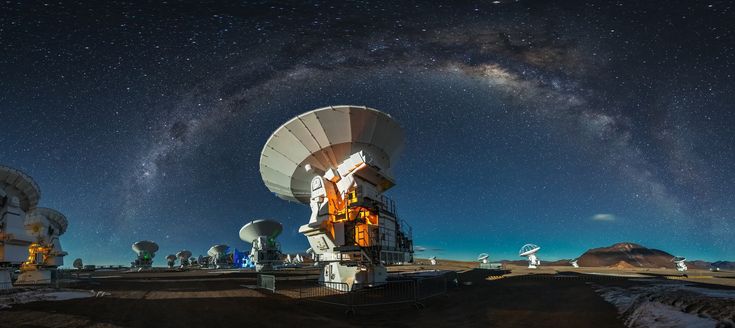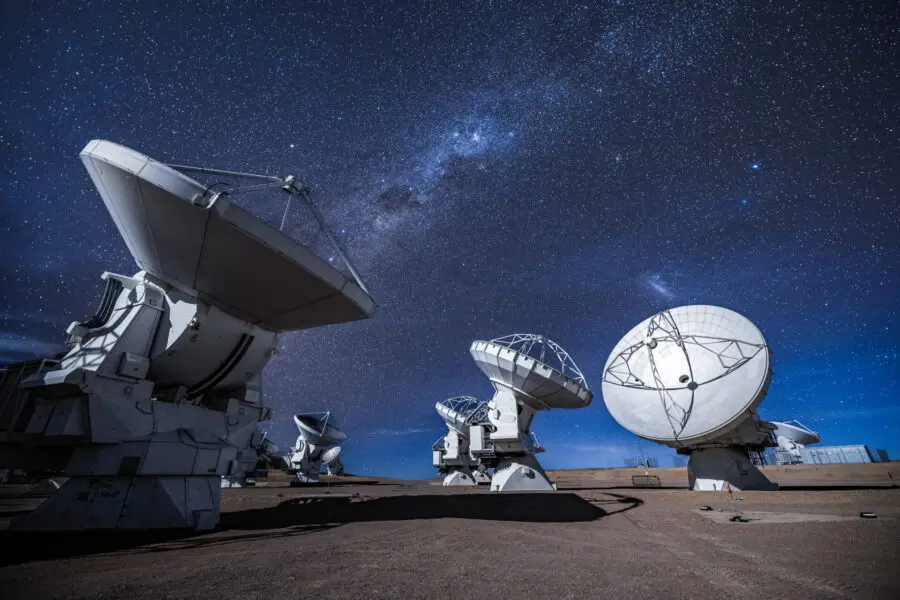Beneath the breathtaking skies of the Atacama Desert lies ALMA, the Atacama Large Millimeter/submillimeter Array, a telescope like no other. It’s here, at 5,000 meters above sea level, that astronomers unravel the mysteries of our cosmic origins. From the formation of galaxies to the birth of stars and planets, ALMA has revolutionized our understanding of the universe. Join me on a behind-the-scenes adventure into the heart of this astronomical marvel.
What Makes ALMA Special?
ALMA is designed to observe the universe in millimeter and submillimeter wavelengths—light invisible to the human eye. These wavelengths reveal the secrets of cold, dusty regions of space, where stars and planets are born. For example, ALMA can peer into the gas and dust disks surrounding young stars, potentially uncovering clues about the formation of planets like our own Earth.
The data collected by ALMA is nothing short of spectacular. Where earlier telescopes saw mere smudges of light, ALMA delivers crisp, detailed images. Unsurprisingly, the competition among scientists to use this facility is fierce, with only one in ten proposals gaining approval.
Where the Magic Begins: The Control Room
Every observation at ALMA starts in its control room. Here, astronomers monitor the incoming data and ensure the alignment of the antennas. Although the raw data may not look impressive initially, it holds the promise of uncovering new galaxies or distant star-forming regions. However, the intricate process of data correlation and image creation can take weeks, requiring patience and expertise.

Heading to the Heights: 5,000 Meters Above Sea Level
Visiting the ALMA site is not for the faint of heart—literally. Situated on the Chajnantor Plateau in the Andes, the altitude requires a medical check and oxygen assistance for the journey. The landscape, however, is worth every breath. The Atacama Desert, one of the oldest and driest regions on Earth, feels like another planet. As we ascend, the barren beauty of the volcanic terrain and the occasional sighting of vicuñas (wild relatives of llamas) add to the surreal experience.
The Antennas: A Symphony in Silver
ALMA’s 66 antennas, each 12 meters in diameter, gleam like silver domes against the stark desert backdrop. These antennas work together as an interferometer, combining their signals to create a single, massive virtual telescope. Depending on the configuration, the antennas can be positioned as close as a few meters or as far apart as 16 kilometers, allowing scientists to study cosmic structures on varying scales.
The antennas are designed to withstand extreme conditions, from harsh winds to temperatures ranging from -20°C to 20°C. Each antenna collects faint light signals from the universe, reflects them through a carefully engineered system, and sends the data via underground fiber-optic cables to a supercomputer called the correlator.
Observing the Invisible Universe
Unlike optical telescopes, ALMA operates in a wavelength range that allows it to see cold gas and dust—the building blocks of stars and planets. Because the sun’s light doesn’t interfere in this range, ALMA can observe day and night. However, the telescope needs to be situated in a dry, high-altitude location like Chajnantor to minimize interference from atmospheric water vapor.
By observing millimeter and submillimeter wavelengths, ALMA reveals a universe invisible to the naked eye. It can track the formation of stars and planets, study distant galaxies, and even detect complex organic molecules in space, offering hints about the potential for life elsewhere.

Moving the Giants: Antenna Transport and Maintenance
Positioning the antennas is no small feat. Custom-built vehicles named Otto and Lore, each 20 meters long and 10 meters wide, transport the 100-ton antennas with millimeter precision. Maintenance is equally impressive, with antennas occasionally brought down to a specialized facility at 3,000 meters for inspection and upgrades. Seeing these colossal instruments up close underscores their engineering brilliance.
A Decade of Cosmic Discoveries
ALMA’s contributions to astronomy over the past decade are nothing short of revolutionary. It has captured stunning images of protoplanetary disks, like the iconic one surrounding HL Tauri, revealing the early stages of planet formation. It has also detected complex organic molecules in these disks, hinting at the building blocks of life.
Perhaps most famously, ALMA played a key role in imaging the black holes at the centers of the galaxy M87 and our own Milky Way. These images not only left the world in awe but also deepened our understanding of the extreme physics surrounding black holes.
A Personal Favorite: A Dying Star’s Legacy
For me, one of the most moving images from ALMA is of the Egg Nebula, a dying star shedding its outer layers in a cosmic finale. These gas and dust clouds will one day give rise to new stars and planets—a poignant reminder that we are all made of stardust.
The Next Frontier
As ALMA celebrates its 10th anniversary, its future looks brighter than ever. Plans are underway to expand its capabilities, and its success has inspired other ambitious projects, like the upcoming Extremely Large Telescope (ELT). Together, these observatories will continue to push the boundaries of our cosmic knowledge.
Standing among ALMA’s antennas, surrounded by the vastness of the Atacama Desert, it’s impossible not to feel a sense of awe. This remote, otherworldly place is a gateway to the universe’s deepest secrets, a testament to human curiosity and ingenuity. Here’s to ALMA and its next decade of discoveries—may it keep inspiring us to reach for the stars.
4o
O
ChatGPT kan



